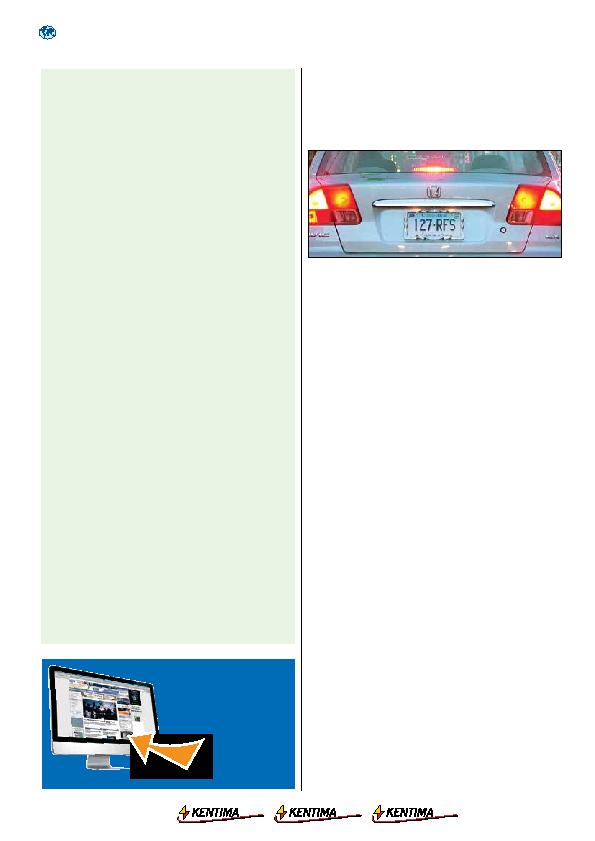
1 4 · d e t e k t o r i n t e r n a t i o n a l
security
technology market
Vehicleentrance
controlmarket
lookstoadoptALPR
According to IHS, the presence of
ALPR technology is increasing the
most for toll ways and off-street
parking garages, which is negative-
ly impacting the growth of vehicle
barriers. In ALPR mature markets
such as the Americas where the
adoption of the technology is
prevalent, highway/toll barrier
revenues are projected to decline
by 16.1% from 2013 to 2017.
Identify vehicles
ALPR systems work by using
cameras with optical recognition
capabilities to identify vehicles
and grant access while minimizing
congestion. Less congestion allows
systems to operate at a higher
profitability thus increasing the
system's ROI in comparison to
traditional barrier solutions.
The most popular use of ALPR
systems is in tolling which allows
cars to pass freely while penalis-
ing unpermitted vehicles through
their license plate registration.
IHS estimated the global tolling
industry to be worth $3 billion in
2013 and projects tolling to be the
fastest growing ALPR application
in the world. The growing trend
of privatisation within the tolling
sector, along with the lack of
government highway financing in
mature markets such as Western
Europe and the United States, has
increased the popularity of ALPR
technology in order to optimise
profitability.
Parking possibilities
A less developed trend is the use
of ALPR technology in off-street
parking systems. ALPR allows for
ticketless off-street parking systems
that can offer subscription or
long-term parking options. These
cameras can not only increase the
effectiveness of parking revenue
by reducing fraud and allowing
for faster ticketless entry, but the
cameras can also be integrated
into 24-hour security systems
which increases their value. IHS
projects parking to be the third
fastest growing application for
ALPR from 2012 to 2017 with
a compound annual growth rate
(CAGR) of 9.4%.
The main barrier for the ALPR
technology is the price. The im-
age quality of ALPR cameras is
crucial for vehicle entrance control
revenue systems because any mo-
tion blur could result in revenue
loss. This requires investment in
both ALPR hardware and software
which can be costly. IHS predicts
the highway/toll barrier market to
be the most significantly impacted
by the increasing adoption of
ALPR technology in the vehicle
entrance control market. The
impact on the off-street park-
ing sector is currently minimal;
however as more parking garages
look to adopt ALPR this will ulti-
mately result in less requirements
for traditional parking hardware.
This could be problematic for sup-
pliers that do not invest in ALPR
technology.
The growing adoption
of automatic license
plate recognition (ALPR)
technology is having an
adverse impact on the
vehicle entrance control
industry, specifically the
vehicle barrier and off-
street parking systems
markets.
Top3Global
MechanicalLockTrends
IHS has recently released its first industry report
on the mechanical and peripheral locking de-
vices market. IHS estimates the world market to
be valued at $5.2 billion in 2013 which includes
products such as electromagnetic locks, electric
strikes, mechanical locks, exit devices, and ac-
cessories. Mechanical locks accounted for the
largest portion of global revenues, 43.2% in
2013. The following are the top three trends in
the global mechanical lock market.
1. Interconnected Locks
Interconnected locks, also
referred to as multi-point
locks, are projected to be the
strongest growing mechani-
cal lock type globally with a
compound annual growth rate
(CAGR) of 4.9% from 2013
to 2017 according to a new
study by IHS.
Interconnected locks
combine a primary locking
device and a deadbolt that are
controlled by a single internal
mechanism when the inside
knob or lever is turned to
open the door. These locks are
mostly used in multi-family
applications and are growing
in popularity due to their con-
venience and robust security.
2. Rising Material Cost
In 2014 the average sales price
(ASP) for mechanical locks
is expected to see an increase
of 1.0% and 0.5% in the
Americas and EMEA regions
respectively. Although low-
cost Asian suppliers have been
increasing their presence in
these regions over the last few
years, IHS expects the rise
of material costs to offset the
decline in ASP from price
competition, with the price
trending upwards.
Mechanical locks can have
many different finishes and
designs depending on applica-
tions and regional preference;
however IHS assumes that
zinc, copper, and steel are the
three most commonly used
components in mechanical
lock production.
3. Grade Level 2 Locks
IHS projects that grade level
2 mechanical locks (based on
ANSI grade level standards)
will experience the strongest
growth globally with a CAGR
of 4.3% from 2013 to 2017.
This is due to an optimistic
outlook for commercial con-
struction in the United States
and Europe as well as the
increasing use of grade level
2 locks in emerging regions.
Grade level 2 locks are best
defined as a standard lock
commonly used in commer-
cial settings.
Business &
Product News
Every Day!
w w w. s e c u r i t y w o r l d h o t e l . c o m
